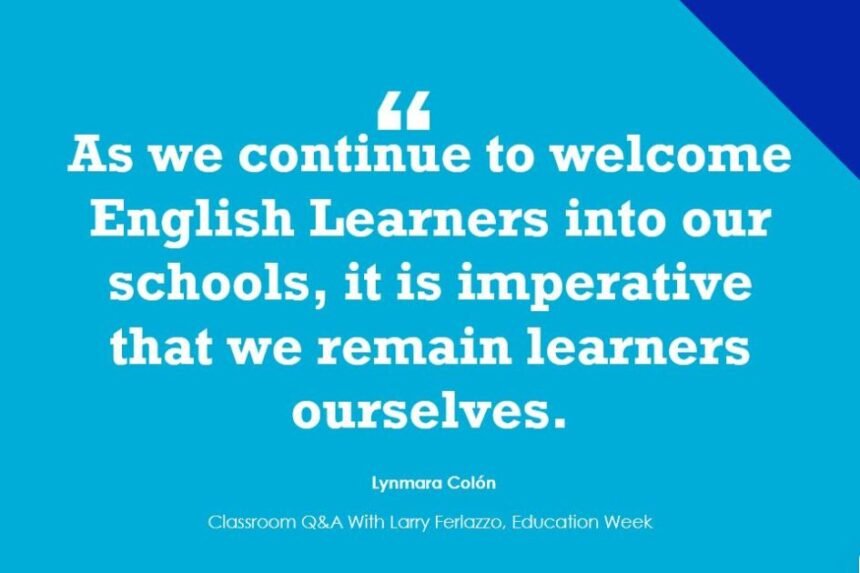Today’s post continues a series in which educators share potential challenges that might exist in teaching English learners and how to overcome them.
Helping ELs ‘to Flourish’
Lynmara Colón, Ph.D., is director of student opportunity and multilingual learners in the Prince William County schools in Virginia:
In the mosaic of American education, English learners add vibrant colors and unique patterns. Every day, as we open our school doors to these students, we embark on a journey of discovery, learning about their diverse backgrounds and distinct needs. This journey is not just an academic pursuit but a personal one, as I, in my role as a director, have the honor of engaging with school leaders, educators, and families, weaving the fabric of our educational community.
The visits to various schools are more than routine checks; they are expeditions into the heart of learning, offering insights into the impact of our support on ELs’ school experiences. These interactions are invaluable, transforming cold, quantitative data into narratives of growth and challenge, painting a picture of life for one of the fastest-growing student populations in the United States.
Through these engagements, I have identified key behaviors that foster an environment where ELs can flourish:
1. Leaders of Els Understand and Prioritize English-Language Development (ELD): Consistency is key across the nation’s schools. Leaders who are committed to the success of ELs recognize the significance of ELD and have made it an indispensable part of the school’s schedule. It is understood that without a solid foundation in ELD, other subjects cannot be effectively taught. These leaders are deeply involved in crafting the school’s timetable, ensuring that it facilitates staff collaboration among their staff and prioritizes ELD.
2. Leaders of Els Focus on Professional Learning to Support ELs: Professional development is crucial for enhancing instructional practices. What sets schools apart from successful EL programs is the expectation that all team members will be well-versed in EL best practices, irrespective of their role. This commitment extends from office staff to art teachers, with professional development sessions tailored to include everyone in the collective effort to support ELs.
3. Leaders of Els Have a Deep Knowledge of Their EL Population: Effective education leadership extends beyond administrative duties; it involves a profound understanding of every student’s unique needs, especially those who speak another language. Leaders who excel in this area are not just familiar with their EL population; they know each student by name and need.
This deep knowledge stems from active participation in data analysis and collaborative learning team meetings with teachers. Such involvement allows leaders to ask critical questions, provide coaching, and, most importantly, understand the nuances of language-proficiency levels and the corresponding support required. As one principal aptly put it, “It’s in these meetings where I get curious, ask questions, and learn about the needs of my students and staff.”
4. Leaders of Els Prioritize Them in Their Budgets: Despite the inadequate funding of many EL programs nationwide, successful leaders understand the difference between equity and adequacy. They implement strategic initiatives supported by thoughtful investments, ensuring that resources are allocated to high-quality instructional materials and professional learning that bolsters language development. At the division level, strategic plans are crafted intentionally to support EL students, with district leaders prioritizing resources to foster an environment where language learning can thrive.
5.Leaders of Els Have High Expectations for Them: Leaders of ELs are their greatest advocates, consistently holding high expectations and refusing to view language as a deficit. Through my visits and interviews, it’s evident that staff under such leadership are committed to serving all students, exhausting all supports before considering grade retention or special education referrals for EL students. This approach ensures that every student is given the opportunity to succeed, reflecting a belief in the potential of all learners.
As we continue to welcome ELs into our schools, it is imperative that we remain learners ourselves, constantly adapting and improving our approaches to meet their needs. It is through this shared commitment to education and inclusion that we can ensure every student has the opportunity to succeed and thrive in our schools.
In conclusion, the success of EL students hinges on leaders who are knowledgeable, budget-conscious, and hold high expectations. These leaders are the cornerstone of an educational environment where every student is valued and empowered to reach their full potential.

Professional Development
Shondel Nero, Ed.D., is an applied linguist and professor of language education at New York University’s Steinhardt School of Culture Education and Human Development. She teaches in the graduate programs in TESOL and bilingual education:
It’s a truism that all teachers, especially in urban centers, are, in fact, functioning in some capacity as teachers of English learners, given the large and increasing numbers of them in public schools, including those that are not formally classified as ELs. There’s some truth to this statement, which leads to some obvious problems:
First, most K-12 teachers do not have formal training in Teaching English to Speakers of Other Languages (TESOL), nor are they licensed to teach English as an additional language. Thus, the majority of teachers are ill-prepared, in terms of linguistic and cross-cultural knowledge, pedagogical, and assessment approaches, to teach ELLs effectively.
Second, the ever-increasing number and diversity of ELs, U.S.- and foreign-born, from a multitude of cultures and linguistic backgrounds, make it even more challenging for teachers to keep abreast of appropriate pedagogical approaches for this population.
Third, the pressure on teachers for their students to demonstrate high academic achievement, mostly measured by successful performance on large-scale standardized tests in English, puts teachers in a perpetual teach-to-the test situation, especially content-area teachers who must teach content and address students’ linguistic challenges simultaneously. The timetable for passing tests to advance to the next grade level is often at odds with the normal time for acquiring language and literacy for academic purposes, even in optimal conditions.
Recommendations:
- Include TESOL training as part of all teacher-preparation programs, regardless of concentration.
- Put financial and human resources into ongoing professional development on teaching ELs for all in-service teachers and school administrators.
- Work with assessment specialists to develop alternative, culturally responsive assessments for all personnel involved in evaluating ELs—regular and special ed. teachers, literacy specialists, speech language pathologists, and school counselors.

‘Support & Patience’
Jenny Vo earned her B.A. in English from Rice University and her M.Ed. in educational leadership from Lamar University. She has worked with multilingual learners during all of her 29 years in education and is currently the Greater Houston area EL director for International Leadership of Texas:
My dad and I immigrated to the United States from Vietnam when I was 8 years old. I started learning English in 2nd grade. I struggled learning how to pronounce and spell the words correctly. I was scared to talk in class for fear of being laughed at. It was hard for me to read the English words because the alphabet and sounds were different from the tonal Vietnamese language. However, with my teachers’ support and patience, I eventually became proficient in English.
Twenty-nine years ago, I started my first job as a 1st grade ESL teacher. In these last 29 years of working with English learners, I’ve heard from teachers of the challenges they have faced and have personally experienced some of these challenges myself. I will share the three biggest challenges below and some solutions for them.
One of the greatest challenges teachers face in teaching English learners is the language barrier, preventing them from communicating with each other. Students struggle to understand the information being shared by the teacher, inevitably leading to misunderstanding the instructions for assignments and tasks. In addition, teachers are not able to check for understanding and know what additional support to provide. This situation naturally would cause frustration for both the teachers and students.
One solution to alleviate this challenge is for teachers to implement differentiation strategies to provide comprehensible input for the students during instruction and accommodate assignments and tasks for students at varying English-language proficiency levels. Teachers can use visual aids and gestures during instruction. They can clarify and repeat.
Teachers can accommodate instructional materials by simplifying the language of the text students have to read. I like using textcompactor.com to accommodate texts because it gives you the option of what percentage of the original text you want to keep in the accommodated text.
Another challenge teachers face when teaching English learners is the differences between American culture and cultures of different countries. There are differences in norms, values, and communication styles.
For example, in American culture, you are expected to look at the people when they are speaking to you. However, in Vietnamese culture, it is considered rude and disrespectful to look directly at the speaker, especially if there is a familial relationship. One way to help overcome this challenge is to provide training for teachers on cultural competency and culturally responsive teaching strategies. Teachers need to have a diverse perspective and make an effort to learn about their students’ backgrounds and respect the different cultures of their students.
How to meet the needs of students of varying English-proficiency levels in one classroom is another challenge teachers of English learners face. There may be students who are newcomers at the beginning stage of learning English. There may be students at the intermediate and advanced levels. There may be English learners who have progressed to the level that is comparable to that of a native English speaker.
To overcome this challenge, teachers can provide students with a language-rich classroom, including visuals and anchor charts. For certain activities, students can be grouped by their language-proficiency level. A choice menu of varying tasks can also be provided to the students. Tiered sentence stems and paragraph frames can be used to model language and teach students grammar and writing structures.
Though teaching English learners is a challenging job, utilizing some of the strategies shared above will, I hope, make the task less challenging. It’s a job that I’ve loved for the last 29 years.

Assets, Not Deficits
Laura Ascenzi-Moreno, professor of bilingual education and bilingual program coordinator at Brooklyn College, City University of New York, is co-author, with Cecilia M. Espinosa, of Rooted in Strength: Using Translanguaging to Grow Multilingual Readers and Writers (Scholastic 2021):
Even though multilingual learners account for a large and growing population of students in U.S. public schools, many professional development books for teachers present their needs as an aside. As a result, teacher knowledge—or, more accurately, lack of teacher knowledge becomes one of the greatest challenges to the success of multilingual learners in schools.
All teachers deserve to have expertise necessary to understand the lives of multilingual students and the valuable resources they bring to school, regardless of their setting. In other words, whether multilingual learners are in bilingual, general-education, or special education classrooms, teachers should be prepared to recognize and leverage their strengths.
How do teachers make necessary shifts in their attitudes and professional knowledge about multilingual students? First, they must develop a robust understanding of multilingual students as a whole. A good start is to reframe the terminology they use to refer to students who use two or more languages in their daily lives. While the term “English learner,” or EL, is widespread, more asset-based terms such as “emergent bilingual” or “multilingual learner” emphasize the multiple-language resources that students possess and bring to school.
Second, teachers must have techniques to identify and value students’ and families’ funds of knowledge. Through observations, dialogue, and surveys, they can learn about their students’ literacy practices, languages, and community resources, even if they are different from their own. Identifying and valuing funds of knowledge can play a key role in the way that teachers plan, select materials, and engage students in learning.
Third, as teachers begin to understand their multilingual students and the resources they bring to school, they can take an analytical stance toward the curricula that they use. Teachers must become critical consumers of curricula and think about how they address the needs of their diverse populations of students, in this case, for multilingual students. Teachers who are critical consumers ask questions such as, “What are my students’ resources and how can they be leveraged through this curriculum?” “Are there opportunities within this curriculum for my multilingual students to use their language resources?” “In what ways does the curriculum reflect and expand upon my multilingual students’ identities?”
The challenges of multilingual students can best be addressed by having all teachers understand, be sensitive to, and be equipped to understand the lives and broad resources of those students.

Thanks to Lynmara, Shondel, Jenny, and Laura for contributing their thoughts!
Today’s post answered this question:
What do you think are the biggest challenges to teaching English learners, and what are your recommendations for how to meet them?
In Part One, Marie Moreno, Anastasia M. Martinez, and Francoise Thenoux shared their responses.
Consider contributing a question to be answered in a future post. You can send one to me at lferlazzo@epe.org. When you send it in, let me know if I can use your real name if it’s selected or if you’d prefer remaining anonymous and have a pseudonym in mind.
You can also contact me on X at @Larryferlazzo or on Bluesky at @larryferlazzo.bsky.social .
Just a reminder; you can subscribe and receive updates from this blog via email. And if you missed any of the highlights from the first 13 years of this blog, you can see a categorized list here.







